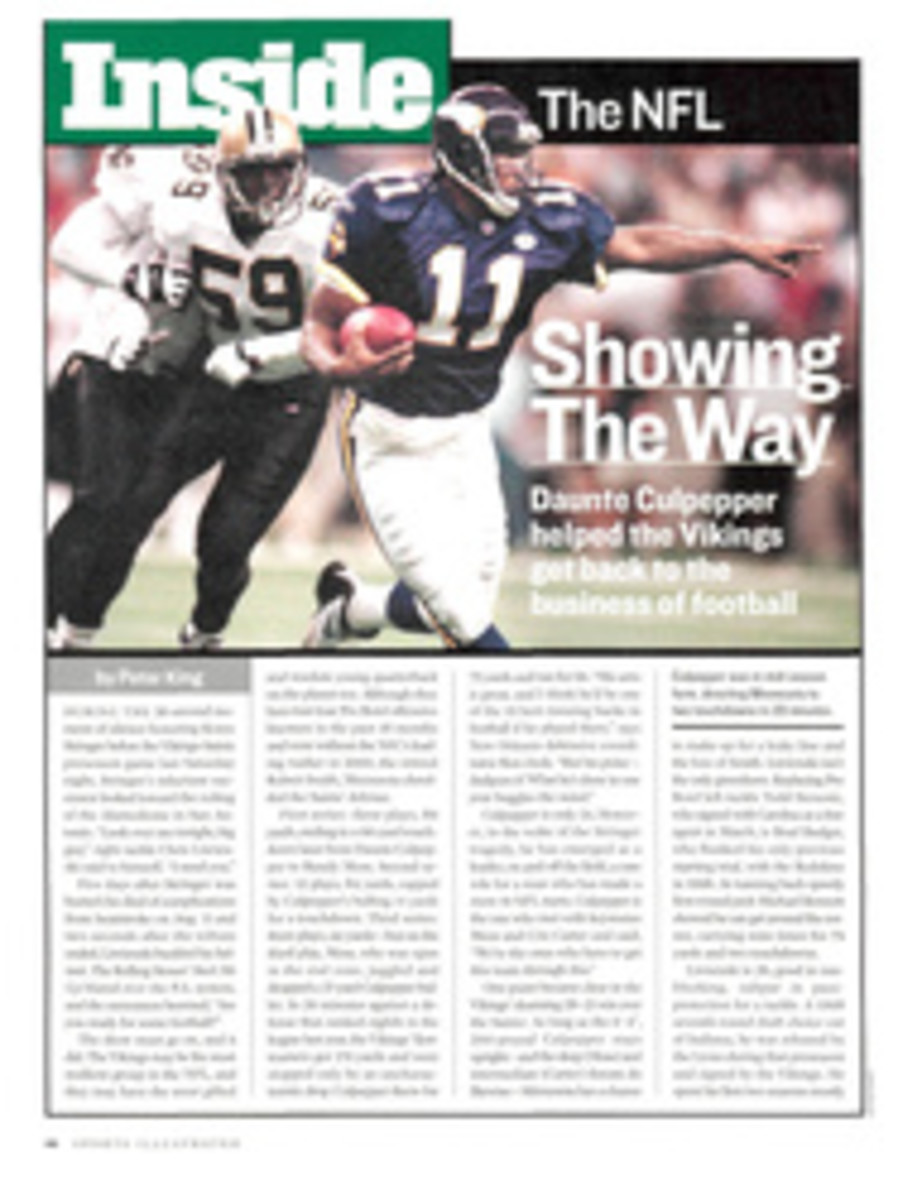
First Strike Weary of being beaten to the punch by blitzing defenses on first down, offenses are throwing caution to the wind and changing the way the game is played
After going 3-8 last season, Colorado coach Gary Barnett spent the
winter searching for answers, and shortly before spring practice
he arrived at this conclusion: The Buffaloes had to improve their
first-down efficiency. He didn't mean how many first downs his
offense made but how many yards it gained on first down. Like
many other coaches, Barnett had to accept that college football
has converted from dial-up to broadband, that the old notion of
an efficient first down being an off-tackle run that sets up
second-and-six has gone the way of artificial turf.
If defenses are blitzing from the time they come onto the field,
then offenses have to respond by throwing over the blitzers.
"First down used to be neutral," Barnett says. "A neutral down
means base defense. Now the defense is thinking, Let's force the
offense into a bad play. On second-and-long, third-and-long, the
defense dictates what happens."
In the Big Ten game that put Purdue in the conference's driver's
seat last season, the blitzing Boilermakers caused Northwestern
quarterbacks Zak Kustok and Matt Danielson to hurry so much that
they completed only five of 11 first-down passes with one
interception. Although the Wildcats scored on their first two
drives, Purdue roared back with the next 27 points and won 41-28.
Calculating college football teams' success--or lack thereof--on
first down isn't easy. The NCAA doesn't keep statistics by down.
Coaching staffs use computers to measure their teams as well as
their opponents by every index save barometric pressure. While
coaches acknowledge that when teams break down the same video,
they come up with the same stats, few coaches are willing to make
the statistics public. To a man, however, they confirm that what
happens on first down dictates the flow of the possession--and,
hence, the flow of the game--more than ever.
The emphasis on first-down play-calling is the latest response to
the aggressive defensive philosophy that has emerged over the
last few years. By positioning as many as nine men in the box
(that area from tackle to tackle) and putting cornerbacks in
man-to-man coverage, defenses have crippled the inside running
that was a staple of college football for generations.
The first counter by offenses was to employ a spread attack (SI,
Oct. 11, 1999), a series of formations employing three, four or
five receivers while leaving one or sometimes no back behind the
quarterback. The second step was the advent of the mobile
quarterback (SI, Aug. 14, 2000), who has become a prerequisite
for thwarting defensive pressure. "Once the quarterback hands off
the ball, you have 10 players and defenses have 11," Notre Dame
offensive coordinator Kevin Rogers says. "Now on first down,
offenses have to use 11 against the defense's 11. You see a lot
of option football, a lot of one-back football. You have the
quarterback run. You're not going to see very many two-back
backfields."
Third-down plays are usually charged with electricity. Whenever
an offense keeps its punter on the sideline for fourth down, the
buzz in the stadium rises as both teams break huddle and meet at
the line of scrimmage. On the other hand there's first down,
which for decades was as bland as white bread. In 1912, when the
NCAA Football Rules Committee increased the number of downs to
gain 10 yards from three to four, it did so in part to reduce the
number of punts on first down when a team had poor field
position, and to inject offense into the game. Four downs also
increased the role of the forward pass, though passing for many
years remained a weapon teams rarely used on first down.
From the single wing to the Notre Dame box to the T and to the I,
the goal of first down was shortsighted: Get in position to make
another first down. The definition of first-down success has
forever been second-and-six. In his 1971 handbook, Power T
Football, Oregon State coach Dee Andros summarized the prevailing
first-down philosophy clearly and concisely. "We will go with our
best play and our strongest back," he wrote, "trying for the
four-yard play."
In 1980, when Vince Dooley won a national championship at
Georgia with freshman tailback Herschel Walker, the Bulldogs ran
on 84% of their first downs. As recently as 10 years ago, says
Arkansas defensive coordinator John Thompson, "on first down you
played base defense, and on second down you hung on. The game
was played on third down."
When Barnett became coach at Colorado in 1999, fans hailed him as
the man who would bring discipline, toughness and national
prominence back to the Buffaloes. After all, Barnett, who'd
served as running backs coach and then offensive coordinator at
Colorado from 1984 through '91, espoused the offensive
philosophy--a punishing running game--of Bill McCartney, who
coached the Buffaloes to the '90 national championship. In that
No. 1 season, Colorado ran on first down more than 81% of the
time.
In 1992 Barnett became the coach at Northwestern. Three years
later, when Barnett led the Wildcats to an improbable Big Ten
championship, tailback Darnell Autry carried the offense, rushing
for 1,785 yards. Even with an experienced, accurate passer in
Steve Schnur, Northwestern ran on first down 81% of the time. The
Wildcats threw only 51 passes on first down all season, and about
a quarter of those were passing situations: Nine came with time
winding down at the end of the first half or the game, and
another four were thrown after penalties, when Northwestern
needed more than 10 yards for a first down. "Until the last two
years, you could take a great tailback and dominate the game,"
Barnett says. "You can't do that anymore. The game has come down
to your quarterback. Your blitz offense becomes your regular
offense."
Last season Colorado ran on first down 62.2% of the time, which
was in part Barnett's concession to the attacking defenses and
also a reaction to often being behind in the score. The
Buffaloes averaged 3.5 yards per first-down rush. Although that
appears to indicate that Colorado nearly averaged
second-and-six, the statistic is misleading. The Buffaloes
rushed for two yards or less on 114 of 209 attempts, or 54.5% of
the time. That left a lot of second-and-longs. Whenever an
opposing defense gets second-and-long, it can lock in the way a
fastball hitter does on a 3-and-1 count.
Months later Barnett couldn't conceal the amazement in his voice
at how defenses had attacked Colorado. Until recently blitzes
weren't used when the opponent was pinned deep in its own
territory. Defenses were content to let field position work for
them. No longer. The Buffaloes saw blitzes no matter where they
had the ball. "It used to be between your 20 and the opponent's
40, you'd see 10 to 15 percent pressure," Barnett says. "Now you
get 50 percent pressure. It's a distinct change."
East Carolina has already made the offensive adjustments that
Colorado is trying to incorporate, a telling point given that
Pirates coach Steve Logan worked with Barnett on McCartney's
offensive staff at Colorado in 1985 and '86. Logan says more
aggressive play-calling on first down revived his offense. "We
used to be a true West Coast offense: five-step drops, quick
passes, make the clock run, pile up first downs, six to eight
plays and score," he says. "Then we started seeing a lot of zone
blitzes, which provide so much disruption to that West Coast line
of thinking." The Pirates' offensive production fell from 28.7
points and 438.2 yards per game in '96 to 19.5 points and 307.0
yards in '97. More important, their win-loss record dropped from
8-3 to 5-6.
"With the number of blitzes we were seeing, it was hard to go 80
yards without making a mistake," says East Carolina offensive
coordinator Doug Martin. "If you do make a mistake, you're
looking at second-and-18, and the drive is over. We realized that
we had to make quick scores. You have to make the big play. First
down is really the time to take a shot."
In 1998 the Pirates began using option runs in their offense to
pull the defenders out of the box. They also let 6'3", 235-pound
David Garrard play quarterback. A 5,000-yard passer for Southern
High in Durham, N.C., Garrard signed with Logan after North
Carolina and North Carolina State said they were interested in
him at tight end or linebacker. With Garrard, who can throw the
ball nearly the length of the field, at the controls over the
past two seasons, the Pirates have averaged 27.0 points per game
and gone 17-7. Last year, with Garrard's having two years'
experience under his belt, East Carolina abandoned caution.
Logan defines an "explosion play" as a run of at least 10 yards
or a pass of at least 15. Of East Carolina's 89 explosion plays
last season, 66 of them occurred on first down. Of the 53
explosion passes, 38 of them came on first-and-10. "When it's
first down," Logan says, "we throw the ball as far as we can." In
the galleryfurniture.com Bowl, Texas Tech unveiled a defensive
game plan full of zone blitzes against East Carolina. Garrard
picked the Red Raiders apart, running up a 34-7 lead at halftime
and coasting to a 40-27 victory.
Even those coaches who don't possess a gambler's soul have begun
to roll the dice. Entering his 10th season as coach at Tennessee,
Phillip Fulmer maintains that his first offensive priority is a
power running game. Nonetheless, on first downs, he says, "we're
trying to be about 50-50 run and pass. Rather than only trying to
get it to second-and-six, which is ideal, we're taking more
shots."
First-down balance used to mean running to the weak side as much
as the strong. Now it means passing on the same number of plays
as running. In 2000 the Vols achieved the new 50-50 balance,
even though Fulmer didn't have an experienced quarterback. When
freshman Casey Clausen, who missed the first two games of the
season because of shoulder tendinitis, made his first start,
against Alabama on Oct. 21, Fulmer didn't hesitate. On the first
play of the game Clausen threw a 44-yard completion to wideout
Donte Stallworth. In the third quarter, when Tennessee scored 10
points to put away the 20-10 victory, Clausen completed all six
of his first-down passes for a total of 103 yards.
The decision by coaches to reach for the big play more often on
first down has made the game more exciting. The question is, How
long it will remain that way? Fulmer says the next step in the
evolution of first-down play-calling may be backward. "People
respond to what the other guy is doing," he says. "Defenses will
look at playing zone on first down to not give up the big play."
That may be wishful thinking. The volatility of first downs
isn't conducive to a long, successful coaching career.
COLOR PHOTO: PHOTOGRAPH BY ROBERT BECK Unloading Last fall Craig Ochs and Colorado learned their first-down lessons the hard way.
COLOR PHOTO: JONATHAN DANIEL Cat on the loose Neither first downs nor Northwestern are boring any longer, not with quarterbacks such as Kustok running free.
COLOR PHOTO: HEINZ KLUETMEIER Retaliation Mobile quarterbacks like Clemson's Woody Dantzler make it easier for offenses to counter attacking defenses.
"You can't take a great tailback and dominate the game anymore.
Your blitz offense becomes your regular offense."

